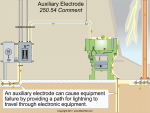Planning for installation of electric actuators on a dam that will be connected to a SCADA system. The actuators have 2 possibilities for grounding, an M5 screw to frame internal to the terminal compartment where incoming power is connected (120VAC/30A), and an external case grounding lug. Here's the problem. Incoming electric service (w/ ground rod) will be approx. 150 ft. from site of these actuators which will be on top of a concrete dam. The dam is also built upon granite ledge with very little possibility of driving a ground rod except for possibly in the water upstream. But actuator manufacturer recommends using separate ground rod to outside ground lug on actuators at that distance (150 ft.) from incoming service, which makes sense. My questions:
1. Would a ground rod fully submerged in water (potentially at high flows) driven partially into streambed be a sufficient ground for actuators?
2. Would there be issues with incoming electric service & PLC/SCADA being on a separate ground from the actuators?
3. Using both grounds (M5 screw a back to service ground rod and external ground lug to local ground rod) with separate rods would create ground loop issues no?
I'm just the instrumentation guy looking to get a plan and wire schedule in the hands of an electrician, but I'm always looking to learn more about this stuff.
1. Would a ground rod fully submerged in water (potentially at high flows) driven partially into streambed be a sufficient ground for actuators?
2. Would there be issues with incoming electric service & PLC/SCADA being on a separate ground from the actuators?
3. Using both grounds (M5 screw a back to service ground rod and external ground lug to local ground rod) with separate rods would create ground loop issues no?
I'm just the instrumentation guy looking to get a plan and wire schedule in the hands of an electrician, but I'm always looking to learn more about this stuff.
Last edited:



